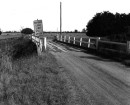WATSON'S HILL
ANDERSON STREET SMYTHESDALE, GOLDEN PLAINS SHIRE
-
Add to tour
You must log in to do that.
-
Share
-
Shortlist place
You must log in to do that.
- Download report
Statement of Significance
This record has minimal details. Please look to the right-hand-side bar for any further details about this record.
-
-
WATSON'S HILL - History
Contextual History:History of Place:
Heritage Inventory History of Site:
08.07.1858: at Watson's Lead the mining surveyor reported that there were two companies employing 36 men; these companies had expended £2598; one was using a 16 hp steam engine and the other was using a whim; two shafts had been sunk and there were two horses being used for mining; there were also companies cutting races to use the water for the surfacing at Watson’s Hill.
At Watson's Hill, Smythesdale
28.12.1895: being sluiced by several parties but they are not making a profit.
WATSON'S HILL DREDGING., Watson Hill
WATSON'S HILL HYDRAULIC SLUICING CO.
BROWNS CREEK DREDGING CO., Browns, moved to Watson's Hill in July 1902.
10.02.1901: preparing to resume operations.
02.03.1901: expects to resume dredging at the beginning of the week.
09.03.1901: resumed sluicing operations; good patches reported; will shift the nozzle on Monday.
16.03.1901: hydraulic nozzle exposing wash.
19.07.1902: The Browns Creek dredge was moved to Watson’s Hill in July 1902 and Alex F. George, foreman of the Staghorn Dredge in North East Victoria - reported to be the most successful dredge in Australia at that time - was appointed manager. The engine had been compounded and all the latest improvements added. Twenty men were employed and it was intended to install a first class electric plant so that sluicing could be conducted in three shifts twenty four hours per day.
27.09.1902: pressing on to get into Watson's gutter; additional power is being supplied to the nozzle by a portable engine.
10.01.1903: working three shifts; returns have not been great because have has to operate with inadequate machinery and a shortage of water.
17.01.1903: hydraulic nozzle working at a pressure of 70 lbs per square inch.
21.02.1903: boxes have been raised, the necessary repairs have been made and sinking has resumed.
09.04.1903: sluicing stopped pending the removal of the barge nearer the site of the operations.
04.07.1903: using a Robertson pump and nozzle.
15.08.1903: repairing machinery and converting from wood to oil fuel.
26.09.1903: new burners resulted in a 50% reduction in the amount of oil used; an acre of ground was used in three weeks.
14.11.1903: greatly handicapped through insufficient boiler power; will install a new one capable of developing 200 hp; will also install a new gravel pump.
06.02.1904: plant has been overhauled.
27.02.1904: better results since the gravel pumps and machinery overhauled; a new Healey pump purchased for the deeper ground.
08.10.1904: operating on a good stope of payable stone.
12.11.1904: being moved to deeper ground and obtaining a more powerful engine
10.12.1904: new boiler 18 foot by 7.5 feet is to be delivered in a few days; the boiler is capable of supplying 200 hp; it will supply the motive power for the new compound engine which has 24 and 16 inch cylinders; the old engine has been compounded to work the nozzle, and will be supplied with steam from one of the old boilers which is 16 foot by 5 foot six inches; the barge has been enlarged to carry the plant.
25.02.1905: dredge working.
16.12.1905: sluicing has been carried on steadily in good faces of wash; pump is working well and its present efficiency will give a good return.
28.07.1906: arranging to move the barge to operate on shallow ground in the northern portion of the paddock.
12.01.1907: after the clean up two weeks before Christmas, the company did not pay their employees as promised and the employees took the company to court where the company was ordered to pay the men.Heritage Inventory Description
WATSON'S HILL - Heritage Inventory Description
Open cut covering an area up to 200m by 200m, with cliffs up to 7m high; there are some shallow sinkings surrounding the cutting; and there are some mullock heaps in the cutting. The area is covered in regrowth forest. Despite gravel removals from certain parts of the site, it is still a large impressive cutting. Large quantities of alluvial material were removed and this had a dramatic impact on the environment.
Heritage Inventory Significance: Regional
-
-
-
-
-
WELCOME STRANGER TOURIST TRAIL
 Victorian Heritage Inventory
Victorian Heritage Inventory -
BEAUMONT CO
 Victorian Heritage Inventory
Victorian Heritage Inventory -
JOHNSTON STREET MULLOCK HEAP
 Victorian Heritage Inventory
Victorian Heritage Inventory
-
-






